1. Project Introduction
BounceBit is a re-staking project built on the Bitcoin ecosystem. Its goal is to enable BTC to generate organic staking rewards by creating a brand new ecosystem - BounceBit Chain.
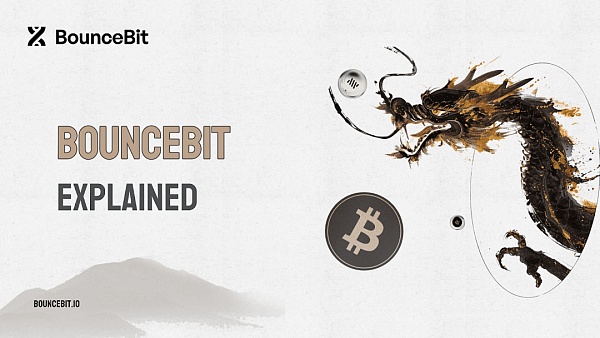
BounceBit's core innovation comes from the BTC re-staking mechanism, and this new concept is the key to driving the project. BounceBit will build a series of infrastructures to explore the use of re-staking on various Bitcoin types. These infrastructures can be in the form of side chains, oracles, bridges, virtual machines, data availability layers, etc. The goal is to support the entire framework through re-staking and aggregated shared security.
By integrating Bitcoin into a Proof of Stake (PoS) first-layer network, BounceBit redefines Bitcoin's role in the blockchain ecosystem. BounceBit not only expands the utility of the world's first cryptocurrency, but also pioneers a token economic model that promises scalability, security, and inclusion.
2. Operational Core Mechanism
2.1 Re-staking Mechanism
One of BounceBit’s core innovations is its BTC re-staking mechanism. Users can convert their Bitcoin into BBTC and then stake it on the BounceBit platform to earn rewards. This mechanism not only improves Bitcoin’s liquidity, but also increases its application in the DeFi ecosystem.
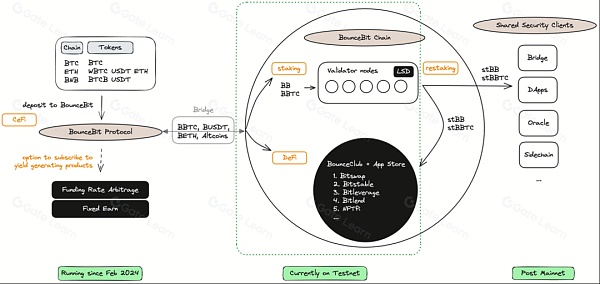
The following is a detailed introduction to the BounceBit re-staking mechanism:
2.1.1 Basic Concepts
The re-staking mechanism is based on converting traditional cryptocurrencies such as Bitcoin into a new form that can be used on the BounceBit platform, commonly referred to as BBTC. This conversion allows Bitcoin that originally did not have a staking function to participate in the staking and consensus process, thereby maintaining its value while increasing additional returns.
2.1.2 Steps and Process
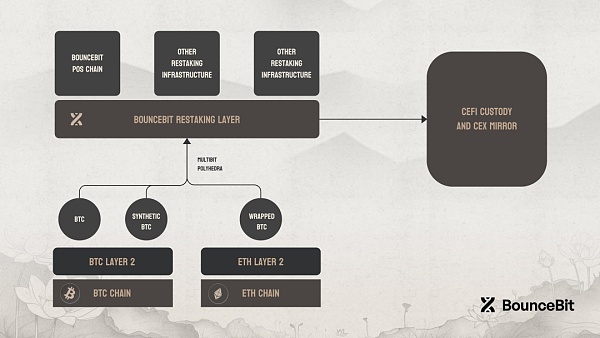
Convert to BBTC: Users first convert their Bitcoin to BBTC. This process is done through BounceBit's cross-chain bridge or directly on its platform. The converted BBTC represents the value of the user's Bitcoin on the original chain.
Pledge BBTC: Once Bitcoin is converted into BBTC, users can stake it on the BounceBit platform. By staking BBTC, users participate in the security of the platform, help maintain the stability of the network and verify transactions.
Get rewards: Users who participate in staking can get rewards, which can be BBTC or another native token of the platform, BB. These rewards come from network transaction fees, new block generation rewards or other economic activities.
2.2 Dual Token System
BounceBit's dual token system is a key design feature that enables the platform to effectively enhance network security, provide a flexible staking mechanism, and promote user participation in its governance structure. This system includes two tokens with different functions: BB and BBTC. Here is a detailed introduction to the two tokens and how they work on the BounceBit platform:
2.2.1 BB Token
BB is the native governance token of BounceBit
2.2.1.1 Main Uses
Network Governance: BB token holders can participate in the governance decisions of the platform, including proposals and voting. This governance model enables community members to directly influence the development direction of the platform and the adjustment of key parameters.
Staking Rewards: BB tokens can be staked in the network to support its operation, and stakers can receive transaction fees and other incentives in return.
Security Guarantee: By staking BB tokens, users help maintain the security of the network and prevent double spending and other types of attacks.
BB tokens are designed to incentivize holders to actively participate in the maintenance and governance of the platform, thereby ensuring the healthy development and long-term success of the network.
2.2.1.2 Token Allocation
The total supply of BounceBit tokens is 21 billion, and its distribution is as follows:
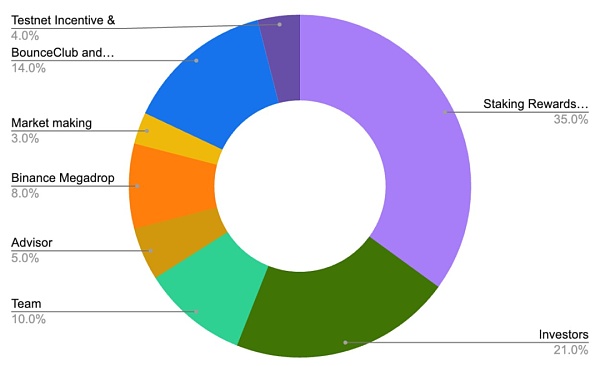
Staking Rewards: 35%, used to reward users who provide staking services for the BounceBit network.
Market: 3%, used to incentivize liquidity providers to provide liquidity for BounceBit trading pairs.
Binance Megadrop: 8%, used to airdrop BB tokens to the public through Binance Launchpad.
Testnet Incentives: 4%, used to reward testnet participants.
Advisors: 5%, used to reward advisors of the BounceBit project.
Team: 10%, used to reward team members of the BounceBit project.
BounceClub and Ecological Reserve: 14%, used to support the development and growth of the BounceBit ecosystem.
Investors: 21%, used to reward early investors.
2.2.1.3 BounceBit Token Release Schedule
BounceBit tokens will be gradually unlocked over four years, with the specific schedule being as follows:
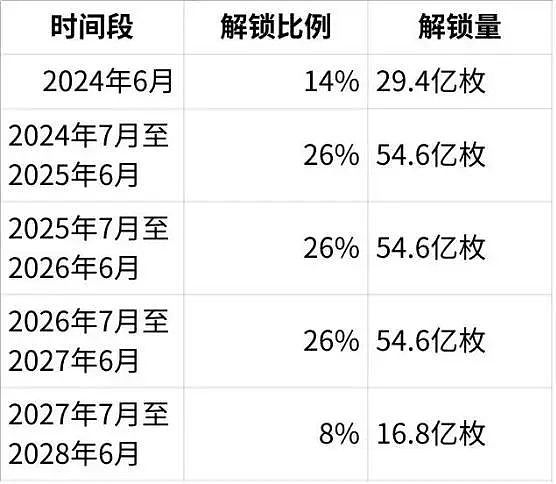
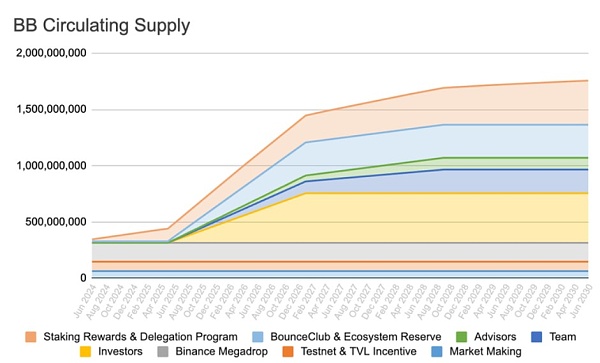
2.2.2 BBTC Token
BBTC is a token pegged to the value of Bitcoin and is primarily used to enable wider adoption of Bitcoin on the BounceBit platform. Its main features and uses include:
Increase Bitcoin liquidity and usability: Users can convert their Bitcoin into BBTC and then use it on the BounceBit platform to participate in various staking and investment opportunities, such as DeFi projects.
Cross-chain function: BBTC can be freely transferred between different blockchains, allowing Bitcoin to circulate and be used in a wider blockchain ecosystem.
Participate in staking and earn income: By converting Bitcoin to BBTC, users not only maintain the value of Bitcoin, but also earn additional income by staking BBTC.
BBTC is designed to solve the problem of low liquidity and fewer application scenarios of Bitcoin on the native chain. Through BBTC, Bitcoin can participate in various blockchain activities more flexibly.
2.2.3 Dual Token Consensus Mechanism
BounceBit's dual token system not only provides diversified economic incentives, but also maintains the security and stability of the network through a unique dual token consensus mechanism. Under this mechanism:
Validators need to stake BB or BBTC to participate in the network's consensus process.
This dual token design enhances the security of the network because it requires participants to hold at least one of the two tokens, thereby increasing the economic cost of network attacks.
2.3 DeFi & CeFi Integration
BounceBit’s DeFi (decentralized finance) and CeFi (centralized finance) integration is one of the core features of the platform, dedicated to building a bridge that seamlessly combines the traditional financial world with blockchain technology. This integration not only provides users with a wider range of financial tools and services, but also enhances the liquidity and accessibility of funds.
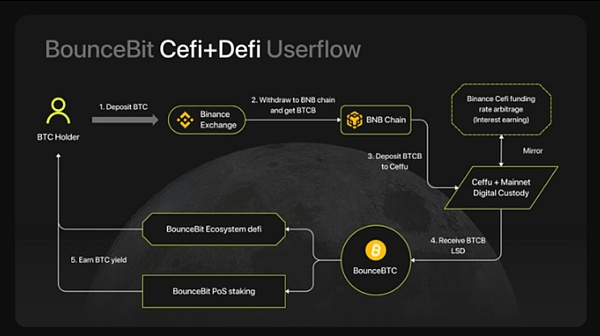
The following is a detailed introduction on how BounceBit achieves DeFi and CeFi integration:
2.3.1 DeFi Integration
1. Smart Contract Platform:
BounceBit is built on the basis of compatibility with Ethereum Virtual Machine (EVM), enabling it to execute smart contracts. This feature allows developers to deploy and run various decentralized applications (DApps) on the BounceBit platform, including lending platforms, automated market makers (AMMs), and other financial protocols.
2. Liquidity Protocol:
By providing a built-in liquidity protocol, BounceBit enables users to stake and borrow their crypto assets. These protocols usually take the form of liquidity pools, where users can deposit their crypto assets in exchange for a share of transaction fees or other forms of income.
3. Tokenized assets:
BounceBit supports tokenized assets, such as BBTC, which allows traditional crypto assets such as Bitcoin to be more active in the decentralized financial ecosystem, and users can use these assets to participate in a wider range of DeFi activities.
2.3.2 CeFi Integration
1. Regulated partners:
BounceBit works with regulated financial institutions to provide centralized financial services. These services include asset custody, fiat currency exchange, and credit services. In this way, BounceBit ensures that financial activities on the platform comply with relevant regulatory requirements.
2. Asset Liquidity and Security:
In terms of CeFi, BounceBit provides liquidity management and safeguards for crypto assets. Collaborating centralized institutions can provide faster transaction processing speeds and higher transaction capacity, while providing insurance and other security measures for user assets.
3. User Interface and Experience:
BounceBit strives to eliminate the boundaries between DeFi and CeFi in user experience. By providing a unified interface, users can seamlessly switch between decentralized and centralized financial products, enjoying the advantages of both without frequently changing platforms or wallets.
2.3.3 Bridging DeFi and CeFi
BounceBit's dual token system (BB and BBTC) provides a liquidity bridge for the integration of DeFi and CeFi. Users can use these tokens to earn returns in the DeFi protocol, or trade and exchange them on the CeFi platform.
BounceBit uses cross-chain technology to realize the free movement of assets between different blockchains, enhancing its support for different financial fields and enabling users to access multi-chain assets on one platform.
2.4 Proof of Stake (PoS)
BounceBit adopts a unique Proof of Stake (PoS) consensus mechanism, which not only enhances the security of the network, but also improves its energy efficiency and scalability. In BounceBit's PoS system, node operators need to stake tokens (such as BB or BBTC) to participate in the network's consensus process and verify transactions. The following is a detailed introduction to the BounceBit PoS consensus mechanism:
2.4.1 Basic Principles of PoS Consensus Mechanism
PoS (Proof of Storage) is a blockchain consensus mechanism that ensures the security and integrity of the network by holding tokens, compared to Proof of Work (PoW). In PoS, validators are selected based on the number of tokens they hold and the time they hold the tokens, rather than the ability to solve complex computational problems.
2.4.2 BounceBit's PoS Features
Dual Token Staking: BounceBit allows users to use two types of tokens—BB and BBTC—to participate in staking and network verification. This increases the diversity of participants and provides more staking flexibility.
Electing validators: In BounceBit's PoS system, token holders can vote to elect trusted nodes as network validators. This process promotes the decentralization of power and increases the degree of decentralization of the network.
Reward mechanism: Validators who participate in PoS staking can receive transaction fees and newly generated tokens as rewards. This reward mechanism encourages more users to join the staking and enhances the security of the network.
Security and stability: By requiring validators to stake a large number of tokens, BounceBit's PoS system increases the cost of launching attacks, thereby improving the security of the network.
Energy efficiency: Compared with PoW, the PoS mechanism is more efficient in energy consumption. BounceBit's use of PoS not only reduces environmental impact, but also improves transaction processing speed and network expansion capabilities.
2.4.3 Roles and Responsibilities of Validators
In BounceBit's PoS system, validators are responsible for key network operations, including:
Verify transactions: Validators are responsible for checking and confirming transactions on the network to ensure their legitimacy and correctness.
Generate new blocks: Validators participate in the generation of new blocks, which record all transactions that have occurred on the network since the previous block.
Maintain network security: Validators help prevent double spending and other types of network attacks through continuous network participation and monitoring.
2.5 Liquidity and Cross-Chain Operations
BounceBit’s liquidity and cross-chain operations are important components of its platform’s functionality, which aims to improve the efficiency and accessibility of crypto assets while connecting different blockchain networks. These features are critical to building an open, interconnected blockchain ecosystem, allowing assets to flow freely and users to seamlessly conduct transactions and other financial activities on multiple platforms. The following is a detailed introduction to BounceBit’s functions and implementation in these two aspects:
2.5.1 Liquidity Management
On the BounceBit platform, liquidity management is achieved through a variety of mechanisms and tools, designed to ensure that users can efficiently and conveniently trade and use their assets.
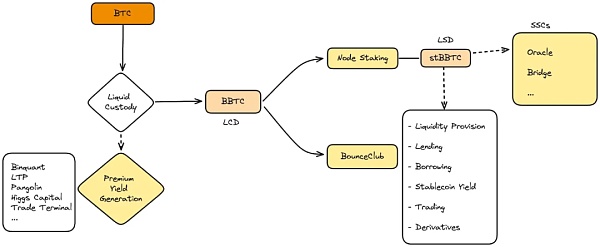
Main liquidity features include
1. Liquidity pools:
BounceBit uses liquidity pools to increase the liquidity of assets within the platform. These pools are usually funded by users, who in turn can receive a portion of the transaction fees in return.
Liquidity pools support a variety of transactions, including token swaps, lending operations, and other complex financial instruments.
2. Automated Market Maker (AMM):
BounceBit can integrate the AMM model, allowing decentralized trading without the need for a traditional order book. Users can interact directly with smart contracts to buy and sell assets through preset algorithms, which improves the efficiency and predictability of transactions.
3. Staking and Reward Mechanism:
To further increase the liquidity of the platform, BounceBit encourages users to stake their tokens (such as BB or BBTC) to support network operations and provide liquidity. In return, users can receive staking rewards, including newly issued tokens or a portion of transaction fees.
2.5.2 Cross-chain Operations
Cross-chain technology enables BounceBit to connect multiple different blockchain networks, allowing assets to move freely between different chains. This is a key technology for achieving widespread blockchain adoption and functional expansion.
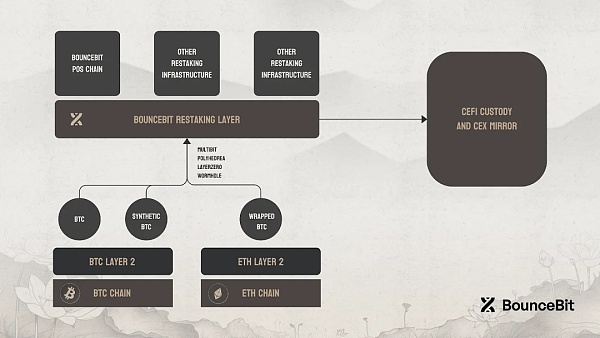
How cross-chain functionality is implemented
1. Cross-chain bridges:
BounceBit develops and maintains cross-chain bridges that allow assets such as BBTC to be transferred from one blockchain to another. This transfer is ensured to be secure and transparent through smart contracts.
Bridge operations can be one-way or two-way, depending on the specific assets and the needs of the target chain.
2. Compatibility and interoperability:
BounceBit ensures that its platform is technically compatible with other major blockchain protocols such as Ethereum, Binance Smart Chain, etc. This includes supporting standardized token protocols (such as ERC-20), which allows these tokens to be issued and traded on different chains.
3. Decentralized identity authentication and security:
Cross-chain operations require a high degree of security, and BounceBit ensures the security and tamper-proofness of cross-chain transactions through multi-signature, smart contract verification, and other encryption technologies.
2.6 Three-party ecosystem
BounceBit's three-party ecosystem is a key component of its platform structure, designed to promote interaction and cooperation among multiple participants, thereby promoting the healthy development and innovation of the entire network. This ecosystem includes three main roles: users (network participants), BB holders, and node operators.
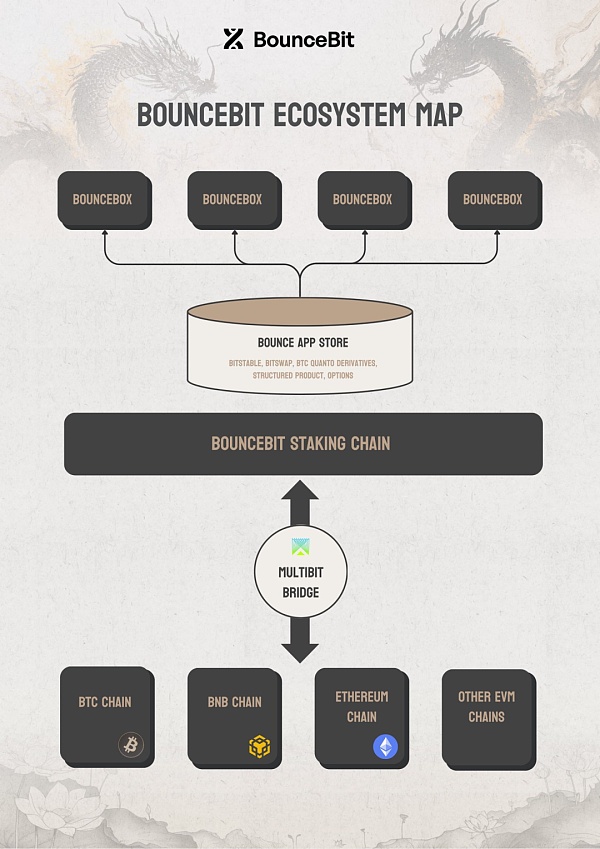
The following is a detailed introduction to these three roles and their functions and roles in the BounceBit ecosystem:
2.6.1 Users (Network Participants)
Users are the foundation of the BounceBit ecosystem and they interact with the platform in various ways:
Transaction Initiators: Users can initiate and execute transactions, such as transfers, purchases, sales, etc.
DApps Utilizers: Users can utilize decentralized applications (DApps) deployed on the BounceBit platform, such as lending platforms, exchanges, games, etc.
Staking Participants: Users can participate in the security maintenance of the network by staking BB or BBTC, while obtaining possible benefits.
The activity of such participants directly affects the vitality and sustainable development of the network, and their trading behavior and staking decisions are also important drivers of network demand and expansion.
2.6.2 BB Holders
BB holders have a key governance role in the BounceBit ecosystem:
Governance Voting: Users holding BB tokens can participate in the governance decisions of the network, including voting on key decisions such as protocol updates and fee structure adjustments.
Staking and Revenue: BB holders can stake their tokens in the network to support the secure operation of the network and obtain staking rewards.
Community Building: BB holders are generally more invested in the long-term success of the platform, and they may participate in community building and promotional activities to help increase BounceBit's popularity and attract new users.
The decisions of this group are crucial to the future direction and development of the platform, and their participation ensures that BounceBit can move forward in accordance with the common interests of holders.
2.6.3 Node Operators
Node operators are technical participants who maintain the security and efficient operation of the BounceBit network:
Transaction Verification and Block Generation: Node operators are responsible for verifying transactions on the network and participating in the generation of new blocks. This is a key responsibility for maintaining the integrity and continuity of the blockchain.
Network Security Maintenance: By running full nodes, node operators help the network resist potential attacks and failures.
Technical Support and Innovation: Node operators are often technological pioneers who may develop new tools and features to improve the performance and user experience of the network.
The stability and reliability of node operators directly affects the health of the entire network. They play the role of infrastructure providers in the entire ecosystem and are an important bridge connecting users and holders.
2.7 LSD (Liquid Staking Derivative)
BounceBit's LSD (Liquid Staking Derivative) flexible staking mechanism is an innovative feature of the platform that allows users to stake cryptocurrencies without sacrificing the liquidity of assets. This mechanism is particularly suitable for users who want to earn returns from their crypto assets but do not want to lock up their assets. LSD solves the problem of insufficient asset liquidity in traditional staking methods by creating a derivative that represents the pledged assets. The following is a detailed introduction to BounceBit's LSD flexible staking: 2.7.1 How LSD works 1. Asset staking: Users first select the assets they wish to stake, such as BB or BBTC. These assets are usually locked in a smart contract to support the security of the network or participate in the consensus mechanism. 2. Issuance of LSD: Once the assets are locked, users will receive corresponding liquid pledge derivatives (LSD), such as stBB or stBBTC. These derivative tokens are freely tradable in the market, and users can use them for other investments or transactions without affecting the security of the original pledged assets.
3. Income and Rewards:
Although the original assets are locked, users can still receive staking rewards by holding LSD. These rewards are usually related to network security, transaction fee sharing, or new block generation.
2.7.2 Advantages of LSD
The biggest advantage of LSD is that it allows users to maintain the liquidity of assets. Even while participating in staking, users can still use or trade their LSD tokens freely.
Users do not need to lock all their assets in one activity or investment. With LSD, they can participate in multiple staking pools or DeFi projects at the same time, thereby diversifying risks.
LSD enables users to adjust their portfolios according to market conditions. For example, when the token price falls, they may decide to sell part of their LSD to reduce losses without canceling the pledge itself.
2.7.3 Use scenarios
LSD can be used in a variety of DeFi protocols, such as lending platforms, liquidity pools, and automated market makers (AMMs). Users can use LSD as proof of liquidity to participate in these protocols and earn additional returns.
Investors can use LSD for more complex financial planning, such as using LSD as collateral for borrowing, or as part of a trading strategy.
By leveraging both staking rewards and LSD market activity, users can maximize the overall return on their assets. 3. Team/Partners/Financing 3.1 Team Most of the BounceBit team remain anonymous. The founder of the project is named Jack Lu. In 2020, Jack Lu became the co-founder of Bounce Finance and withdrew from the project. BounceBit currently has 15 employees and plans to recruit more talents.
3.2 Investors/Partners
The latest investment from Binance Labs has helped BounceBit gain high attention from the community. Although the amount of funding was not disclosed, Binance Labs stated that it will support the project to expand the functionality of Bitcoin as well as traditional value storage.
At the end of February, BounceBit successfully raised $6 million led by Blockchain Capital and Breyer Capital.
Some notable seed round investors include CMS Holdings, Bankless Ventures, NGC Ventures, Matrixport Ventures, DeFiance Capital, OKX Ventures, and HTX Ventures.
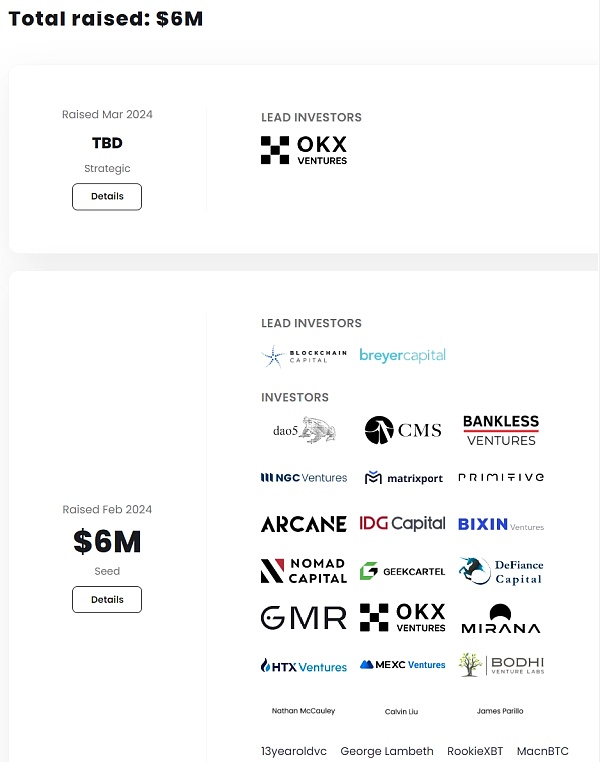
The project’s main angel investors include Anchorage Digital co-founder and CEO Nathan McCauley, EigenLayer strategy director Calvin Liu, and Brevan Howard portfolio director Ashwin Ayappan.
4. Project Evaluation
4.1 Track Analysis
The BounceBit project belongs to multiple track fields, mainly DeFi (decentralized finance), cross-chain technology and staking services. These tracks together constitute the core value proposition of BounceBit: enhancing the liquidity and profit potential of assets by utilizing the re-staking mechanism of assets such as Bitcoin in a multi-chain environment.
BounceBit's business model:
Transaction fees: BounceBit charges a certain percentage of fees through various transactions conducted on the platform (such as token exchange, staking, etc.).
Staking reward sharing: The platform may extract a portion of the rewards obtained by users through staking as management fees.
Cooperation and integration: Cooperate with other DeFi and CeFi projects to obtain income by providing technical support or liquidity support.
Service objects:
Cryptocurrency investors: users who hope to increase the income of their assets through staking and other methods.
Cross-chain users: users who need to move assets between different blockchains, seeking efficiency and security.
DeFi participants: users who seek advanced financial tools and permissionless financial services.
Similar projects
Lido Finance: Provides liquidity staking services, allowing holders of assets such as Ethereum to pledge assets without losing liquidity. The stETH provided by Lido is a liquidity staking derivative, similar to the LSD provided by BounceBit.
Rocket Pool: Another DeFi project that provides Ethereum staking services, which also supports pledgers to maintain a certain amount of liquidity.
Thorchain: Focuses on providing cross-chain liquidity solutions, allowing assets on different blockchains to be freely traded and interchangeable, similar to BounceBit's cross-chain functionality.
4.2 Project Advantages
The BounceBit project has many advantages that make it stand out in the highly competitive cryptocurrency and blockchain market. The following is an analysis of BounceBit's main advantages:
1. Innovative staking solutions
BounceBit introduces the concept of LSD (liquidity staking derivatives), allowing users to maintain the liquidity of assets while participating in staking and supporting network security. This model is an attractive option for users who want to earn returns from their crypto assets but are unwilling to bear the liquidity risks of traditional staking and locking assets.
2. Cross-chain functionality
BounceBit's cross-chain technology allows Bitcoin and other cryptocurrencies to flow freely between different blockchain platforms. This not only improves the efficiency and accessibility of assets, but also enhances the interoperability and scalability of the entire crypto market. For users and developers, this means that resources from multiple blockchain networks can be accessed and utilized on a unified platform.
3. EVM compatibility
By being compatible with the Ethereum Virtual Machine (EVM), BounceBit is able to support a wide range of smart contracts and decentralized applications (DApps), which enables the platform to attract a large number of existing Ethereum developers and projects. This compatibility also means that BounceBit can quickly integrate new features and applications to maintain its technological leadership.
4. Enhanced security and decentralization
BounceBit adopts a dual token system and Proof of Stake (PoS) consensus mechanism, which not only improves the security of the network, but also enhances the network's anti-censorship and decentralized characteristics by decentralizing power. The dual token system also incentivizes users to actively participate in network governance and maintenance, enhancing the community's sense of participation and the stability of the platform.
5. Comprehensive DeFi and CeFi advantages
BounceBit's platform combines the advantages of decentralized and centralized finance, providing an ecosystem covering a wide range of financial services. This integration allows users to experience fast and convenient CeFi services and flexible and transparent DeFi applications on the same platform to meet the needs of different users
4.3 Project Disadvantages
Although the BounceBit project has shown significant advantages in many aspects, like all technological and business innovations, it also faces some potential challenges and disadvantages. The following are possible disadvantages and limitations of the BounceBit project:
1. Complexity and User Adaptability
BounceBit introduces multiple innovative concepts and technologies, such as LSD (liquidity pledge derivatives), cross-chain operations, and dual-token systems, which may be difficult for ordinary users to understand and adapt to. This complexity may hinder the adoption of new users, especially those who are not familiar with cryptocurrency operations.
2. Security Risks
Although BounceBit has adopted advanced security measures, cross-chain technology and smart contracts themselves bring new security challenges. Cross-chain bridges and smart contracts may become targets of hacker attacks, especially when there are vulnerabilities in the code. Security vulnerabilities may lead to theft of funds or tampering of data, which will damage user trust.
3. Regulatory and Compliance Risks
BounceBit may face regulatory challenges in different jurisdictions when trying to integrate DeFi and CeFi functions. In particular, cross-chain transfers involving cross-border transactions and assets may trigger complex compliance requirements. Failure to adapt to the changing regulatory environment of various countries may lead to legal risks and affect the sustainable development of the project.
4. Competitive Pressure
While BounceBit offers innovative solutions in multiple areas, it still needs to maintain its leading position in a highly competitive market. There are many mature competitors in the market, such as Lido and Thorchain, which have established a strong user base and brand recognition. BounceBit needs to continue to innovate and improve in order to stand out in such an environment.
5. Dependence on Technology and Market Changes
BounceBit's success depends heavily on the advancement of blockchain technology and the overall state of the crypto market. Market volatility and uncertainty in technological developments may affect the project's performance and users' returns on investment. In addition, as blockchain technology develops, new technologies may make current solutions obsolete.
5. Conclusion
BounceBit and its token economics represent a major leap forward in the fusion of traditional financial concepts with cutting-edge blockchain technology. By incorporating Bitcoin into its PoS network and providing innovative staking solutions, BounceBit not only increases the utility of BTC, but also sets a new standard for token economics. As the platform continues to develop, it is expected to become a cornerstone of the next generation of blockchain infrastructure, providing users, holders, and validators with a stable, secure, and scalable environment to grow their digital assets.
 JinseFinance
JinseFinance















